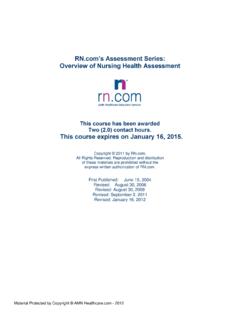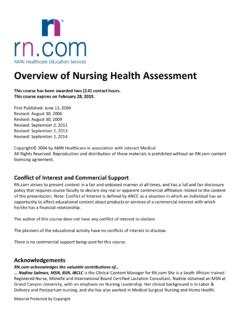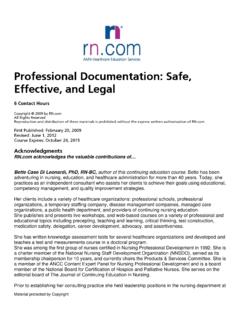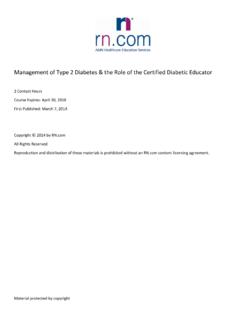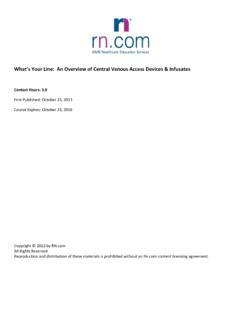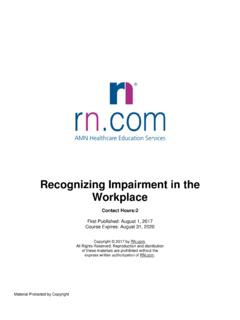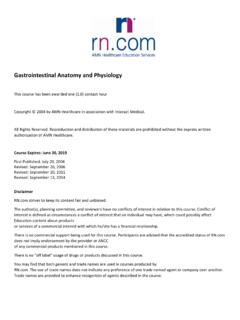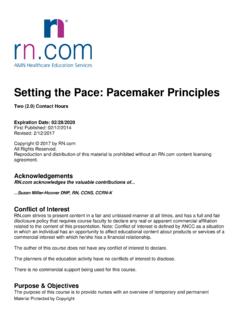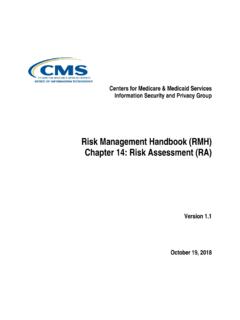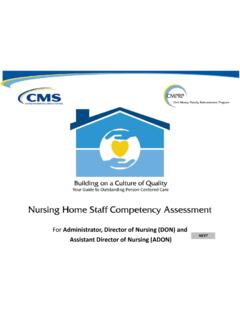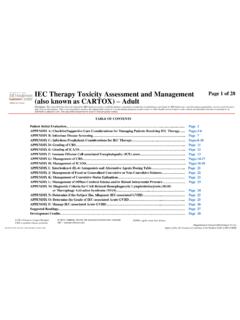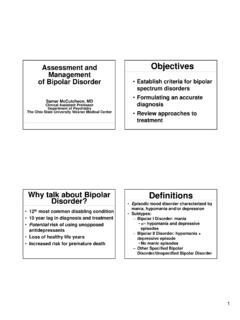Transcription of Pain Assessment and Management - RN.com
1 Material protected by copyright pain Assessment and Management One ( ) Contact Hour Course Expires: 12/31/2016 First Published: 9/12/2013 Reproduction and distribution of these materials is prohibited without the express written authorization of Material protected by copyright Acknowledgements acknowledges the valuable contributions of .. Kim Maryniak, RNC-NIC, BN, MSN. Kim has over 23 years staff nurse and charge nurse experience with medical/surgical, psychiatry, pediatrics, and neonatal intensive care. She has been an educator, instructor, and nursing director. Her instructor experience includes med/surg nursing, mental health, and physical Assessment .
2 Kim graduated with a nursing diploma from Foothills Hospital School of Nursing in Calgary, Alberta in 1989. She achieved her Bachelor in Nursing through Athabasca University, Alberta in 2000, and her Master of Science in Nursing through University of Phoenix in 2005. Kim is certified in Neonatal Intensive Care Nursing and is currently pursuing her PhD in Nursing. She is active in the National Association of Neonatal Nurses and American Nurses Association. Kim s current and previous roles in professional development included nursing peer review and advancement, education, use of simulation, quality, and process improvement. Her current role includes oversight of professional development, infection control, patient throughput, and nursing operations.
3 Conflict of Interest strives to present content in a fair and unbiased manner at all times, as has a full and fair disclosure policy that requires course faculty to declare any real or apparent commercial affiliation related to the content of this presentation. Note: Conflict of Interest is defined by ANCC as a situation in which an individual has an opportunity to affect educational content about products or services of a commercial interest with which he/she has a financial relationship. The author of this course does not have any conflict of interest to declare. The planners of the educational activity have no conflicts of interest to disclose. There is no commercial support being used for this course.
4 Purpose and Learning Objectives The purpose of this course is to provide nurses with an overview of pain Assessment and strategies for managing pain . This course will cover material associated with Assessment and Management of pain with adult and pediatric patients. pain in the neonate is outside the scope of this course. After successful completion of this course, you will be able to: Identify basic physiology of pain . Describe appropriate components of pain Assessment . Describe developmental and individual patient considerations in assessing pain . Identify pharmacologic and non-pharmacologic interventions to alleviate pain . Discuss considerations with using opioids.
5 Introduction pain can be a common experience for patients in the hospital setting. It is integral to the role of a nurse to effectively assess and manage the perception of pain for patients. Nurses require both the knowledge and skills to appropriately plan and provide interventions for pain . Material protected by copyright The Centers for Disease Control and Prevention (CDC) conducted the National Health Interview Survey in 2010. 30% of respondents over the age of 18 stated they had migraines, back pain , neck pain , or facial pain within the three months prior to the survey (CDC, 2012). It is also estimated that 100 million people in the suffer from chronic pain , resulting in approximately $560-$635 billion annually in healthcare costs (Institute of Medicine, 2011).
6 pain Defined pain is defined as an unpleasant sensation caused by noxious stimulation of the sensory nerve endings. It is a subjective feeling and an individual response to the cause. pain is a cardinal symptom of inflammation and is valuable in the diagnosis of many disorders and conditions. It may be mild or severe, chronic or acute, lancinating, burning, dull or sharp, precisely or poorly localized, or referred. Experiencing pain is influenced by physical, mental, biochemical, psychological, physiologic, social, cultural, and emotional factors (Mosby s Medical Dictionary, 2012). Process of pain Nociception is the process where information about tissue damage is conveyed to the central nervous system through sensory receptors (nociceptors).
7 There can be pain without nociception (such as phantom limb pain ), or nociception without pain . pain occurs through four activities: Transduction: Energy is converted from a noxious stimulus (thermal, mechanical, or chemical) into electrical energy (nerve impulses) by nociceptors Transmission: The transmission of the neural signals from the transduction site to the spinal cord and brain Perception: In higher structures, the arriving signals are appreciated as pain Modulation: Occurs at the spinal cord level; descending input from the brain influences (modulates) nociceptive transmission (American pain Society, 2007) Types of pain pain is categorized as nociceptive or neuropathic, depending on the underlying pathophysiology.
8 Nociceptive pain Nociceptive pain is caused by the ongoing activation of nociceptors responding to noxious stimuli (such as inflammation, injury, or disease). Visceral pain arises from visceral organs, while pain coming from tissues is called somatic pain . In nociceptive pain , the central nervous system is functioning appropriately. There is a close association between the intensity of the stimulus and the perception of pain , indicating real or potential tissue damage. Neuropathic pain Neuropathic or pathologic pain is caused by abnormal signals in the central or peripheral nervous systems, demonstrating injury or impairment. Causes of neuropathic pain may include inflammation, trauma, infections, tumors, metabolic diseases, toxins, or neurological disease (American pain Society, 2007).
9 Material protected by copyright Types of pain (Alexander, 2013; American pain Society, 2007). Test Yourself Which type of pain arises from organs? Neuropathic Visceral - Correct! Somatic Acute versus Chronic pain pain can be classified as acute or chronic. Acute pain is complex, and is described as an unpleasant experience with an identifiable precipitating cause. Acute pain generally has defined pathology, and can resolve with healing of the underlying injury. Acute pain can also be seen as a reflexive and protective response. Chronic pain is described as pain that persists at least three months beyond the expected course of an acute injury or illness. Chronic pain can also disrupt activities of daily living and sleep, and has no protective purpose (Alexander, 2013; American pain Society, 2007).
10 Material protected by copyright Acute vs. Chronic pain (Alexander, 2013; American pain Society, 2007). pain Assessment pain is often referred to as the fifth vital sign, and should be assessed regularly and frequently. pain is individualized and subjective; therefore, the patient s self-report of pain is the most reliable gauge of the experience. If a patient is unable to communicate, the family or caregiver can provide input. Use of interpreter services may be necessary. Components of pain Assessment include: a) history and physical Assessment ; b) functional Assessment ; c) psychosocial Assessment ; and d) multidimensional Assessment . History and Physical Assessment The Assessment should include physical examination and the systems in relation to pain evaluation.
